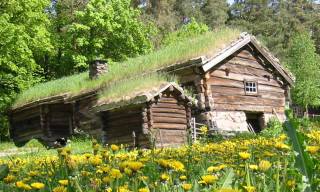I happen to love architecture, I always have. I’m one of those strange people who measures time by my landmark acquisitions. However, I believe anyone can learn to write about structures (from castles, to space stations, to huts) by asking themselves a few simple questions about how they want to use the building in the setting.
- Think about the building’s purpose.
Your primary building will most likely be housing. So, how long has your character(s) lived there? How do they feel about the house, sentimental or resentful? Make sure you give your building enough square footage to meet the demands of your story. Did you write about a huge extended family smashed into a few tenement rooms, or about a single person rattling around in a huge empty nest of a chateau?

- Give the structure a basic shape and composition.
Please, don’t restrict yourself to squares or rectangles unless the story calls for it. Think about giving your building curves and angles. Is your building made of bricks or maybe wood? What about the roof? Is it covered in grass, perhaps with a few goats nibbling on it? If you’re writing fantasy, you can use influences from a few different cultures to invent something other worldly. If you write historical fiction and don’t want to use a real structure, combine elements from several structures to create something fresh.

- Use regional details.
Building influences come out of the availability (or scarcity) of local materials and climate considerations. Wraparound porches, screened sleeping rooms, matched windows and doors for cross ventilation are all common to warmer locations. Think about your character’s needs. What would make them comfortable or uncomfortable? How would they interact with nature, on a patio, or buffered from the outside in a solarium?
- Work your five senses on the space.
Think about what your old house smells like, the flowers in the yard or the food cooking on the neighbor’s stove. What does your house sound like? Most wood houses creak, but houses set on adobe ground often pop. What about street noises? Do the doors and windows scrape as they stick? And what sort of windows are they, big glass walls that flood the rooms with light? Or are they small dirty windows that let in almost no light at all?
- Create a blueprint of your building, if not your whole world.
You don’t need great art skills to create a template of your building, a basic layout will do. Record all the details. You may not use them all, in fact, it’s better if you don’t. When your character stumbles on the front steps you’ll know if he falls down two steps or ten.
- Give your character some social standing.
How does your character’s structure relate to the other buildings in the area? Is your protagonist’s shop the smallest store in a fancy resort town? Or the grandest store in a crime ridden ghetto? No structure exists in a vacuum; they’re always influenced by the surrounding land and the other buildings. By paying attention to this detail, you can create a sense of community and the illusion that you’ve described a real place.
- Show us who lives there.
Are they concrete thinkers, people seeking to bring order to everything? Set them in a white house with symmetry, and long linear lines. Are they free spirited people, with an arty style? Set them in a home with lots of color and jutting greenhouse windows. Even small details can tell the reader a lot. Remember don’t be afraid of mixing it up, everyone loves a maverick, someone who defies convention because s/he can.
If you learn to write about structures with skill they can become a huge asset to your story, as much a part of the work as any of your characters.
Happy house crafting everyone!
Up next from Robin… Into the Wild: Creating Landscape Settings.
I loved this post, thank you. There are details here that no one else seems to mention, like using the surrounding environment to shape and form the buildings. I’ve never seen anyone else mention goats munching on a green roof!
I’ve only recently found your blog, and I’ve spent the last two days absorbing as much as I could from it, and then making notes. Brilliant site, lots of wisdom and a great place to hang out and learn.
Thank you so much for sharing your collective brilliance!